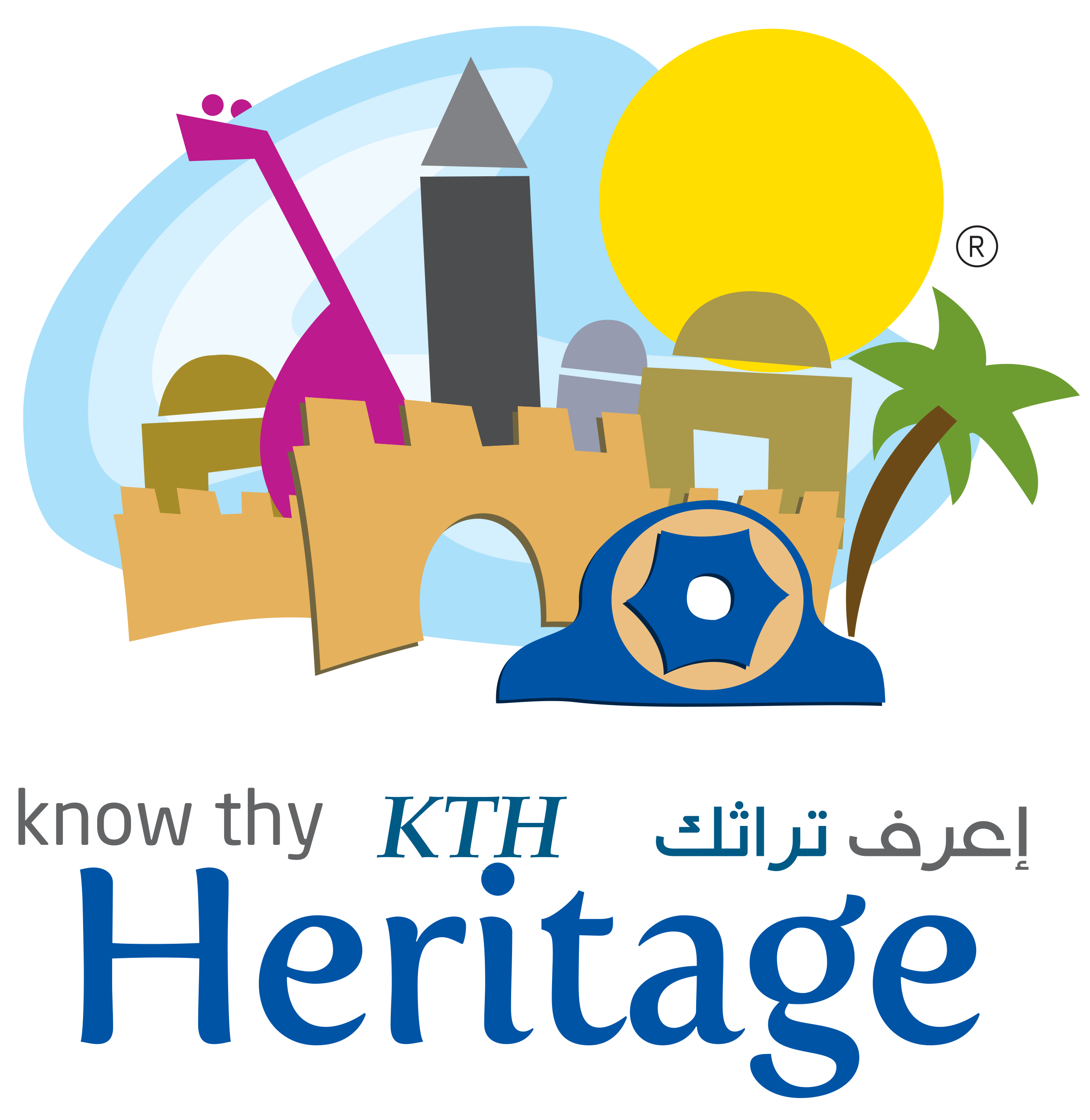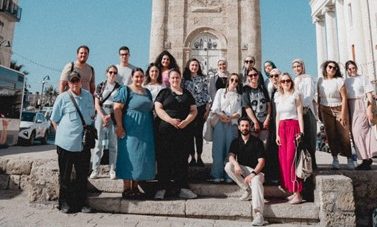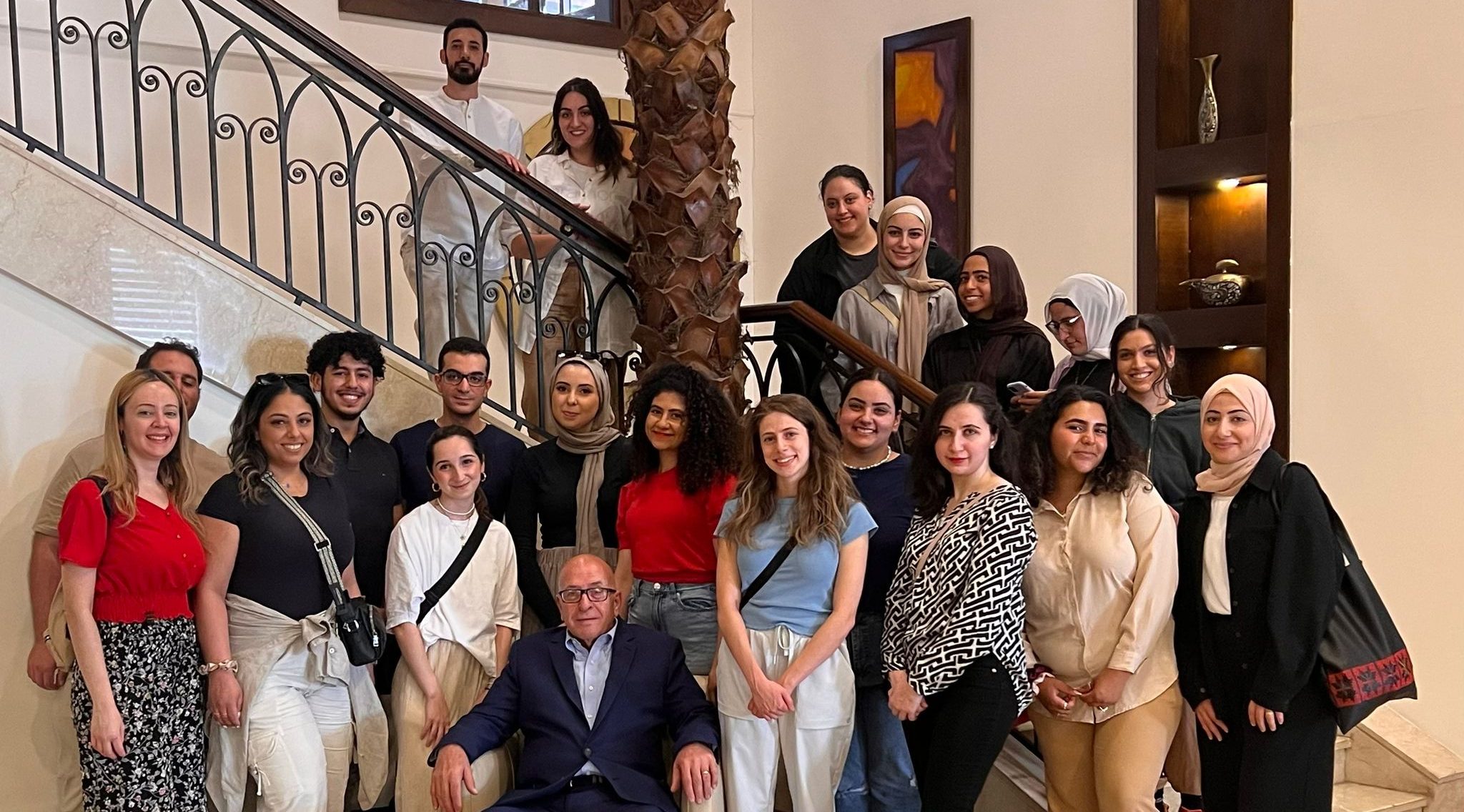Day 12: A Journey Through Palestine’s 1948

Day 12: A Journey Through Palestine’s 1948
By Reem A.
Day 12 marked a geographical shift for the 11th Know Thy Heritage Delegation: visiting three cities—Nazareth, Iqrit, and Yaffa. The KTH delegation embarked on an exploration of the north of Palestine, a journey that would unveil a different side of history, culture and colonization that was not quite possible to see while staying in the familiar territories of the West Bank, the “more Palestinian” areas.

Our journey commenced in Nazareth, also known as Al-Nasirah, where 30 grand churches punctuated the skyline of this relatively small city, a testament to the holy city’s global reverence as the Virgin Mary’s home. As we ate breakfast in the hotel overlooking the picturesque mountain view of the sacred city, our fellow delegates eagerly shared their excitement for the day’s adventures, a fact that was no surprise considering that six out of 21 delegates in KTH originally hailed from Yaffa, who were particularly elated to revisit their homeland.
Our first stop was the renowned Basilica of Annunciation, where Angel Gabriel’s divine revelation to the Virgin Mary to bear her son still echoed through the grandeur of the Italian Catholic architecture. Our interfaith group—comprised of Palestinian Muslims and Christians—stood in awe, absorbing this sacred site’s historical and spiritual significance. Yet, what truly captured our attention were the myriad depictions of the Virgin Mary from nations across the globe—such as Spain, the Dominican Republic, Croatia, Honduras, China, Korea, etc.

This painted a vivid picture of universal devotion to Jesus Christ and the significance of Palestine as the holy land across the globe. Inside the basilica is arguably the most famous site in Nazareth, the Grotto of Annunciation, believed to cradle the remnants of the Virgin Mary’s childhood home. This journey through Nazareth allowed us to truly grasp the essence of “Historic Palestine.”
Just around the corner from the Church of Annunciation lay the White Mosque, also known as Al-Masjid Al-Abyad, embodying the peaceful coexistence of Muslims and Christians in Nazareth and Greater Palestine. The mosque’s architecture bore the distinctive marks of Ottoman influence, its beige brick walls, semi-circular flat dome, blue-green accents and towering, thin minarets serving as tributes to northern Palestine’s multicultural influence. Despite divisive media coverage of Palestine as a “battleground” for Christians and Muslims, particularly in Western media, getting to experience Palestine and especially holy sites in Palestine puts these falsehoods to rest.

Iqrit “the first lost Palestinian town.”
Our next destination, Iqrit, was a place shrouded in both sorrow and
resilience. Despite the 15-minute hike to the top of the mountain in the sweltering North where Iqrit is located, we beamed with excitement, thrilled to learn about a place described to us as “the first lost Palestinian town.” Upon reaching its barren mountaintop, a solitary church stood, a silent sentinel of the community that once thrived here.

As we entered the church, a gracious local and friend of the church gave us a brief history lesson, explaining to us the story of Iqrit. It is a story of villagers living in peace and prosperity for over 400 years until one day, a high-ranking Israel Defense Force (IDF) member visited the town and asked to speak to the community leader. They obliged, and on behalf of the IDF, the high-ranking soldier “strongly advised” the Palestinian community in Iqrit to evacuate for a mere two weeks under the guise of caring about the civilians’ well-being, ensuring them that they could return and all would be well in just 14 days. However, as Palestinians, we know this story all too well. The community members were not allowed to return to their homes and, instead, ended up having bombs dropped on every building in their town except the church. This heart-wrenching narrative struck a chord with us, resonating deeply with the familiar tale of Palestinians offering kindness only to be deceived and left with nothing. Iqrit’s story illuminated the Palestinian people’s unwavering spirit and commitment to preserving their culture and heritage.
 The highlight of our day awaited us in Yaffa, where a fair amount of us had ancestral ties. After a three-hour journey through “the Palestinian path,” rather than traveling through the easier Israeli routes, we arrived to meet Palestinian politician and activist Sami Abu Shehadeh, who leads the Arab political party “Balad” (country) to advocate for Palestinian rights in the Knesset, the Israeli Parliament. Though our conversation with him was short-lived, my fellow delegates and I would agree that Mr. Abu Shehadeh brought about a different feeling for many of us, acting differently than what we expected the traditional Palestinian politician in the Knesset to be like. He was very transparent with his answers and motivations while also balancing his opinions with logic and understanding of history and people’s behaviors. Seeing a politician authentically voice their opinion without fear of judgment from fellow colleagues was profoundly refreshing for many of us.
The highlight of our day awaited us in Yaffa, where a fair amount of us had ancestral ties. After a three-hour journey through “the Palestinian path,” rather than traveling through the easier Israeli routes, we arrived to meet Palestinian politician and activist Sami Abu Shehadeh, who leads the Arab political party “Balad” (country) to advocate for Palestinian rights in the Knesset, the Israeli Parliament. Though our conversation with him was short-lived, my fellow delegates and I would agree that Mr. Abu Shehadeh brought about a different feeling for many of us, acting differently than what we expected the traditional Palestinian politician in the Knesset to be like. He was very transparent with his answers and motivations while also balancing his opinions with logic and understanding of history and people’s behaviors. Seeing a politician authentically voice their opinion without fear of judgment from fellow colleagues was profoundly refreshing for many of us.

Guided by a knowledgeable local, we traversed Yaffa’s old city, framed by the deep blue waters that justified its Canaanite name, “the most beautiful view.” The city’s charm presented itself to us, with every door, step, and sign adorned in fluorescent yellow or deep sea blue, continuing to keep the city’s pre-Nakba glory alive. As we continued, we encountered a seemingly inexplicable sight: a massive coppery egg suspended in the air by two chains, cradling a growing tree. Our guide unveiled the significance of the orange trees—a symbol of resilience, abundance and fertility in Palestine. Yaffa was once synonymous with oranges, attracting laborers from far-flung corners of the world during the four months of harvest season a year, such as Egypt, Syria, India, Afghanistan, etc. Centuries ago, Yaffa was bountiful in the business of orange trees and harvesting oranges, even having a specific type of orange named after them, the “Yaffa orange.” This delightful and cheery tone in conversation quickly flipped as he informed us that no orange farms were left in Palestine.
They had all been harvested. A symbol of the beautiful fruits and glories of Palestine no longer existed due to the colonization of Yaffa, a devastating reality for many of our group members, especially the Yaffa-ites, to reckon with as a majority of our families have an ancestral connection to oranges. To many of us, it felt so significant that a vibrant and defining part of the Palestinian lifestyle and the economy had been killed off due to outside interference.
Our journey through the old city culminated at Yaffa’s breathtaking coastline, renowned as one of the most significant and beautiful in the Middle East. As we stood in awe of its beauty, some of us, especially those with Yaffa roots, sat down to pray and do meditative work, reconnecting with the land and their ancestors who we felt never truly left Palestine.

With a substantial portion of our delegation having ties to Yaffa, we were afforded the opportunity to venture out on our own, connecting with the land in ways that resonated with our personal backgrounds and family histories. Whether it was enjoying the vibrant local cuisine, purchasing handmade Palestinian crafts to gift to our families back home, or simply basking in the city’s essence, Yaffa embraced us all.
As we bid farewell to Yaffa, our hearts heavy with the weight of its colonization yet absolute beauty, we headed back to the West Bank to our beloved Ramallah. In customary fashion, we concluded the day with a debriefing session, contemplating the profound impact of our visit to Yaffa. For many, especially those with roots in Yaffa, it was a day etched with deep emotion—a journey that allowed us to physically and spiritually reconnect with our homeland despite the reminders of what had been taken from us. In the heart of Yaffa, the Palestinian spirit shone bright, resilient as ever, and unwavering in its commitment to preserving culture and heritage, a fact the KTH delegation embraced and accentuated.




